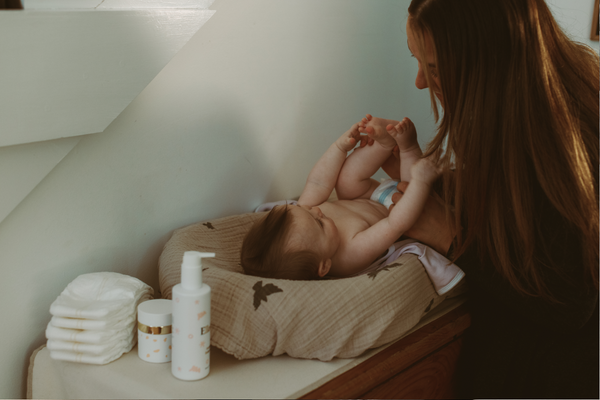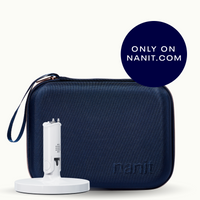There are many myths and incorrect assumptions about teething including that teething causes fever. Teething does not cause a fever (temperature at or above 100.4F / 38C). Drooling is not a sign of teething, drooling starts at three months when babies start to make more saliva. While we may see drooling when a baby's teeth are erupting, babies will drool regardless. Drooling does not necessarily mean teeth are imminent. Starting around 3 months babies also enjoy putting things in their mouths and may rub their gums with their hands or whatever they can get a hold of, often a cloth or blanket. If your baby seems uncomfortable it is first important to assess if something else is upsetting them or determine if they have an actual fever (100.4F/38C). A relaxed environment will always facilitate soothing a cranky baby. Maintaining a good and consistent overnight sleep and nap schedule is essential as overtired babies will often be cranky.
How to help your teething baby sleep
The upside of teething? It’s a sign that your baby is well on their way to joining you at the dinner table. Not for the reasons you’d think as babies don’t need teeth to eat first foods. We chew our food with molars that don’t typically erupt until after 12 months. The first teeth to erupt do so between 4 and 12 months of age and typically are the bottom central incisors (bottom middle teeth). So the initiation of complementary foods corresponds with an age when many babies get their first tooth.
We often assume that teething is very painful and disruptive to a baby’s sleep. There is in fact some evidence that teething does not have a significantly negative effect on sleep in the majority of infants and toddlers. However, it seems reasonable to assume that as a tooth is erupting through the gum line your baby may be a bit uncomfortable. It’s hard to know definitively if they are fussy at night due to teething or something else. What is most important is to first determine if there is another reason that explains your baby’s fussiness before assuming it’s teething, determine if a visit to your pediatrician is necessary, and if neither of these two, figure out a way to comfort and soothe your baby.
As a parent or caregiver, you’re in a prime position to soothe your baby’s discomfort and help your little one get adequate and restful sleep. Read on for tips to help your baby through the very normal teething process.
How to soothe teething pain
Wondering how to know if your baby is teething? The only real way is to visualize a cut in the gums where the tooth is beginning to erupt. Some babies sail right through getting teeth with little more than a few whimpers while other infants appear to be in more discomfort. It’s important to only presume “teething” is the cause of fussiness once you have assessed your infant for other causes. Once it’s clear that teeth are erupting, there are a handful of safe and savvy ways to ease your baby’s discomfort:
- Apply cold therapy. Cooled teething toys can offer relief to your child by decreasing the discomfort from mild gum inflammation and swelling. You might try a chilled washcloth that they can chomp on; wet a clean washcloth with water and place in the fridge (or freezer for 15 min). The nubbiness of the cold washcloth feels particularly good when rubbing it against their gums. You could also offer a cold teething ring made of firm rubber. Teething children who have been introduced to solid foods often find some comfort by gnawing on a frozen banana or bagel (Safety Tip: to minimize choking risk, the frozen food products should be offered in a mesh feeder)
- Distract your child. The more relaxed your baby is, the less they may focus on their discomfort. Soft, relaxing music, cuddling, rocking, and humming can help relax your baby, encourage sleep and comfort them despite some gum discomfort.
- Use a dry toothbrush. Massaging a dry, soft-bristled toothbrush (without toothpaste) or a finger brush on your baby’s gums may feel nice and provide some relief.
With the guidance of your pediatrician, the use of occasional pain relievers may be helpful (Acetaminophen only until 6 months of age. Acetaminophen or Ibuprofen can be given beginning at 6 months of age). It’s important not to rely on daily/nightly medication. Using pain relievers more than 1-2 days at a time may be masking another cause for the fussiness.
There are some teething remedies that can be potentially dangerous. The CDC advises against using homeopathic teething gels and tablets, liquid-filled teething toys, and teething jewelry. Bracelets, anklets and necklace can pose a choking hazard and necklaces pose a strangulation risk.
How to help a teething baby sleep
The benefits of sleep—for both you and your baby—are many: Your baby shifts into growth and repair mode during sleep. And research shows that well-rested parents are more comfortable and confident in their soothing abilities and are able to help their baby settle and self-regulate more effectively.
With this in mind, here’s how to help a teething baby sleep:
- Try a massage. Applying gentle pressure to your baby’s gums, back, and limbs can both diminish their gum pain and encourage the deep relaxation they may need to fall asleep.
- Give your baby extra cuddles. It may sound basic, but it works. Studies suggest that more cytokines are generated at night to manage inflammation, but they can also amplify your baby’s discomfort just as it’s time for bed. Giving your little one an extra snuggle may be just enough to settle for a good nights sleep.
- Create a soothing sleep environment. Temperature, light, and sound all have an impact on your baby’s sleep. So, set your child’s sleeping space to an ideal temperature of between 68 and 72 degrees, and add white noise with Nanit’s Sound + Light Machine, an audio monitor, nightlight, and sound machine that offers you and your baby just the right amount of illumination and serenity.
Look forward to bedtime with the Nanit Sound and Light Machine, designed to grow with your child from the early days of newborn sleep through toddlerhood and beyond. This all-in-one device creates a soothing and consistent sleep environment to promote more restful routines.
How to help your child maintain oral hygiene
Oral hygiene is vital to your child’s dental health, as well as to their overall wellness. Set the stage for a lifetime of confident smiles by:
- Brushing your baby’s new tooth or teeth with water on a soft toothbrush. Start with a rice grain of children’s fluoride toothpaste at 1 year of age. The small volume is safe if swallowed. Once your child can spit, (sometimes not until 3-4 years old), a pea size of fluoride toothpaste is recommended.
- Flossing between teeth as more of your baby’s teeth erupt
- Running a damp, clean washcloth across your baby’s gums
- Refraining from giving your baby a bottle that they suck on for a prolonged period while falling asleep. Bathing teeth with formula or breastmilk can damage tooth enamel if it remains on the teeth during sleep.
Using Nanit to monitor baby’s sleep during teething
Learning how to help a teething baby largely boils down to supplying your child (and yourself) with love, patience, and understanding. Pair that with some of the more practical tips discussed above and you’ll be able to weather the teething times if your baby is one that is more sensitive to the discomfort. Nanit is here to be part of your support team. Our Pro Camera monitor and app are the ideal tools for observing your child’s sleep while they’re teething (and in general), as our built-in sound and movement detection allows you to observe your child, helping you know when to tend to them or let them self-soothe.
Key takeaways
- Try safe and easy at-home soothing tricks. To soothe a teething baby, try a cold compress, relaxing music, a dry toothbrush, or for a particularly rough night, infant pain reliever approved by your pediatrician.
- Get creative to help your child fall asleep. Try massaging your baby’s gums before bedtime, cuddling them a little extra, and creating an optimal sleeping environment. Set the room temp to between 68 and 72 degrees and use a white noise machine like Nanit’s Sound + Light.
- As babies teeth begin to erupt, start good habits. Use an infant toothbrush or a clean washcloth to rub gums or first teeth. Avoid allowing your baby to sleep with the bottle or breast in their mouth, milk residue can build up on their teeth and cause cavities.
Sources:
Parents. How to soothe a teething baby at night.
https://www.parents.com/baby/sleep/how-can-i-help-my-baby-sleep-while-hes-teething/
Children’s Hospital Los Angeles. Your infant is teething: know the signs and symptoms.
https://www.chla.org/blog/advice-experts/your-infant-teething-know-signs-and-symptoms
Healthy Children.org. How to help teething symptoms without medications. https://www.healthychildren.org/English/ages-stages/baby/teething-tooth-care/Pages/How-to-Help-Teething-Symptoms-without-Medications.aspx#
US Food a& Drug Administration. Safely soothing teething pain and sensory needs in babies and older children. https://fda.gov/consumers/consumer-updates/safely-soothing-teething-pain-and-sensory-needs-babies-and-older-children
PLos One. Infant crying and the calming response: parental versus mechanical soothing using swaddling, sound, and movement. https://www.ncbi.nlm.nih.gov/pmc/articles/PMC6481793/
Mayo Clinic. Lack of sleep: can it make you sick?
https://www.mayoclinic.org/diseases-conditions/insomnia/expert-answers/lack-of-sleep/faq-20057757
Healthline. What is the best room temperature for baby?
https://www.healthline.com/health/baby/room-temperature-for-baby
Nemours Kids Health. How do I care for my baby’s teeth?


































